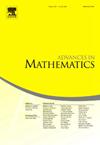Sharp asymptotic stability of Blasius profile in the steady Prandtl equation
IF 1.5
1区 数学
Q1 MATHEMATICS
引用次数: 0
Abstract
This work presents an asymptotic stability result concerning the self-similar Blasius profiles of the stationary Prandtl boundary layer equation. Initially demonstrated by Serrin [13], the profiles were shown to act as a self-similar attractor of solutions to the Prandtl equation through the use of von Mises transform and maximal principle techniques. Specifically, as , . Iyer [6] employed refined energy methods to derive an explicit convergence rate for initial data close to Blasius. Wang and Zhang [16] utilized barrier function methods, removing smallness assumptions but imposing stronger asymptotic conditions on the initial data. It was suggested that the optimal convergence rate should be , treating the stationary Prandtl equation as a 1-D parabolic equation in the entire space.
In this study, we establish that . Our proof relies on discovering nearly conserved low-frequency quantities and inherent degenerate structures at the boundary, which enhance the convergence rate through iteration techniques. Notably, the convergence rate we have demonstrated is optimal. We can find special solutions of Prandtl's equation such that the convergence between the solutions and the Blasius profile is exact, represented as .
稳态Prandtl方程中Blasius剖面的渐近锐稳定性
本文给出了关于平稳Prandtl边界层方程的自相似Blasius剖面[u¯,v¯]的渐近稳定性结果。最初由Serrin[13]证明,轮廓[u¯,v¯]通过使用von Mises变换和极大原理技术被证明是Prandtl方程解[u,v]的自相似吸引子。具体为:x→∞、‖u−u¯‖Ly∞→0。Iyer[6]采用精细的能量方法推导出接近Blasius的初始数据的显式收敛速率。Wang和Zhang[16]利用障碍函数方法,去掉了小假设,但对初始数据施加了更强的渐近条件。将平稳Prandtl方程视为整个空间中的一维抛物方程,提出了最优收敛速率为‖u−u¯‖Ly∞≤(x+1)−12。在本研究中,我们建立了‖u−u¯‖Ly∞> (x+1)−1。我们的证明依赖于在边界处发现几乎守恒的低频量和固有的简并结构,通过迭代技术提高了收敛速度。值得注意的是,我们已经证明的收敛速度是最优的。我们可以找到Prandtl方程的特殊解,使得解与Blasius轮廓之间的收敛是精确的,表示为(x+1)−1。
本文章由计算机程序翻译,如有差异,请以英文原文为准。
求助全文
约1分钟内获得全文
求助全文
来源期刊

Advances in Mathematics
数学-数学
CiteScore
2.80
自引率
5.90%
发文量
497
审稿时长
7.5 months
期刊介绍:
Emphasizing contributions that represent significant advances in all areas of pure mathematics, Advances in Mathematics provides research mathematicians with an effective medium for communicating important recent developments in their areas of specialization to colleagues and to scientists in related disciplines.
 求助内容:
求助内容: 应助结果提醒方式:
应助结果提醒方式:


